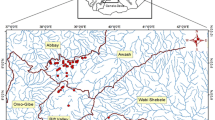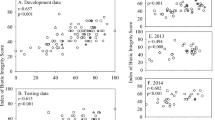Abstract
A benthic index of biotic integrity was developed for use in estuaries of the mid-Atlantic region of the United States (Delaware Bay estuary through Albemarle-Pamlico Sound). The index was developed for the Mid-Atlantic Integrated Assessment Program (MAIA) of the U.S. Environmental Protection Agency using procedures similar to those applied previously in Chesapeake Bay and southeastern estuaries, and was based on sampling in July through early October. Data from seven federal and state sampling programs were used to categorize sites as degraded or non-degraded based on dissolved oxygen, sediment contaminant, and sediment toxicity criteria. Various metrics of benthic community structure and function that distinguished between degraded and reference (non-degraded) sites were selected for each of five major habitat types defined by classification analysis of assemblages. Each metric was scored according to thresholds established on the distribution of values at reference sites, so that sites with low scoring metrics would be expected to show signs of degradation. For each habitat, metrics that correctly classified at least 50% of the degraded sites in the calibration data set were selected whenever possible to derive the index. The final index integrated the average score of the combination of metrics that performed best according to several criteria. Selected metrics included measures of productivity (abundance), diversity (number of taxa, Shannon-Wiener diversity, percent dominance), species composition and life history (percent abundance of pollution-indicative taxa, percent abundance of pollution-sensitive taxa, percent abundance of Bivalvia, Tanypodinae-Chironomidae abundance ratio), and trophic composition (percent abundance of deep-deposit feeders). The index correctly classified 82% of all sites in an independent data set. Classification efficiencies of sites were higher in the mesohaline and polyhaline habitats (81–92%) than in the oligohaline (71%) and the tidal freshwater (61%). Although application of the index to low salinity habitats should be done with caution, the MAIA index appeared to be quite reliable with a high likelihood of correctly identifying both degraded and non-degraded conditions. The index is expected to be of great utility in regional assessments as a tool for evaluating the integrity of benthic assemblages and tracking their condition over time.
Similar content being viewed by others
Literature Cited
Adams, D. A., J. S. O’Connor, andS. B. Weisberg. 1998. Sediment quality of the NY/NJ harbor system. Final report. An investigation under the Regional Environmental Monitoring and Assessment Program (REMAP). EPA/902/R-98/001. U.S. Environmental Protection Agency—Region 2, Division of Environmental Science and Assessment, Edison, New Jersey.
Alden, III,R. W., D. M. Dauer, J. A. Ranasinghe, L. C. Scott, andR. J. Liansó. 2002. Statistical verification of the Chesapeake Bay Benthic Index of Biotic Integrity.Environmentrics 13: 473–498.
American Society for Testing Materials. 1993. Guide for conducting 10-day static sediment toxicity tests with marine and estuarine infaunal amphipods. ASTM E-1367-92. American Society for Testing Materials, Philadelphia, Pennsylvania.
Barbour, M. T., J. Gerritsen, G. E. Griffith, R. Frydenborg, E. McCarron, J. S. White, andM. L. Bastian. 1996. A framework for biological criteria for Florida streams using benthic macroinvertebrates.Journal of the North American Benthological Society 15:185–211.
Bradley, M. P. andR. B. Landy. 2000. The mid-Atlantic integrated assessment (MAIA).Environmental Monitoring and Assessment 63:1–13.
Bricker, S. B., C. G. Clement, D. E. Pirhalla, S. P. Orlando, andD. R. G. Farrow. 1999. National Estuarine Eutrophication Assessment: Effects of Nutrient Enrichment in the Nation's Estuaries. National Oceanic and Atmospheric Administration, National Ocean Service, Silver Spring, Maryland.
Bulich, A. A., M. W. Greene, andD. L. Isenberg. 1981. Reliability of the bacterial luminescence assay for determining toxicity of pure compounds and complex effluent, p. 338–347.In D. R. Branson and K. L. Dickson (eds.), Aquatic Toxicology and Hazard Assessment, Proceedings of the Fourth Annual Symposium, ASTM STP 737. American Society for Testing and Materials, Philadelphia, Pennsylvania.
Chaillou, J. C., S. B. Weisberg, F. W. Kutz, T. E. DeMoss, L. Mangiaracina, R. Magnien, R. Eskin, J. Maxted, K. Price, andJ. K. Summers. 1996. Assessment of the ecological condition of the Delaware and Maryland coastal bays. EPA/620/R-96/004. U.S. Environmental Protection Agency, Office of Research and Development, Washington, D.C.
Culliton, T. J., M. A. Warren, T. R. Goodspeed, D. G. Remer, C. M. Blackwell, andJ. J. McDonough, III. 1990. 50 years of population change along the nation’s coast. Second report of a Coastal Trend Series. National Oceanic and Atmospheric Administration, National Ocean Service, Rockville, Maryland.
Dauer, D. M. 1993. Biological criteria, environmental health and estuarine macrobenthic community structure.Marine Pollution Bulletin 26:249–257.
Dauer, D. M., M. F. Lane, H. G. Marshall, andK. E. Carpenter. 1998. Status and trends in water quality and living resources in the Virginia Chesapeake Bay: 1985–1997. Prepared for the Virginia Department of Environmental Quality, Richmond, Virginia. Old Dominion University, Norfolk, Virginia.
Eaton, L. 2001. Development and validation of biocriteria using benthic macroinvertebrates for North Carolina estuarine waters.Marine Pollution Bulletin 42:23–30.
Engle, V. D. andJ. K. Summers. 1999. Refinement, validation, and application of a benthic condition index for Northern Gulf of Mexico estuaries.Estuaries 22:624–635.
Engle, V. D., J. K. Summers, andG. G. Gaston. 1994. A benthic index of environmental condition of Gulf of Mexico estuaries.Estuaries 17:372–384.
Harding, L. W. 1994. Long-term trends in the distribution of phytoplankton in Chesapeake Bay: Roles of light, nutrients and stream flow.Marine Ecology Progress Series 104:267–291.
Hilsenhoff, W. L. 1987. An improved biotic index of organic stream pollution.Great Lakes Entomologist 20:31–39.
Hyland, J. L., L. Balthis, C. T. Hackney, G. McRae, A. H. Ringwood, T. R. Snoots, R. F. Van Dolah, andT. L. Wade. 1998. Environmental quality of estuaries of the Carolinian Province: 1995. Annual statistical summary for the 1995 EMAP-Estuaries Demonstration Project in the Carolinian Province. NOAA Technical Memorandum NOS ORCA 123. National Oceanic and Atmospheric Administration, National Ocean Service, Office of Ocean Resources Conservation and Assessment, Silver Spring, Maryland.
Hyland, J. L., W. L. Balthis, C. T. Hackney, andM. Posey. 2000. Sediment quality of North Carolina estuaries: An integrative assessment of sediment contamination, toxicity, and condition of benthic fauna.Journal of Aqualic Ecosystem Tress and Recovery 8:107–124.
Karr, J. R. 1981. Assessment of biotic integrity using fish communities.Fisheries 6:21–27.
Karr, J. R., K. D. Fausch, P. L. Angermeier, P. R. Yant, andI. J. Schlosser. 1986. Assessing biological integrity in running waters: A method and its rationale. Special Publication 5. Illinois Natural History Survey, Urbana, Illinois.
Lenant, D. R. 1993. A biotic index for the southeastern United States: Derivation and list of tolerance values, with criteria for assigning water-quality ratings.Journal of the North American Benthological Soceity 12:279–290.
Liansó, R. J., L. C. Scott, D. M. Dauer, J. L. Hyland, andD. E. Russell. 2002. An estuarine benthic index of biotic integrity for the mid-Atlantic region of the United States. I. Classification of assemblages and habitat definition.Estuaries 25: 1219–1230.
Long, E. R., D. D. Macronald, S. L. Smith, andF. D. Calder. 1995. Incidence of adverse environmental effects within ranges of chemical concentrations in marine and estuarine sediments.Environmental Management 19:81–97.
Malone, T. C. 1987. Seasonal oxygen depletion and phytoplankton production in Chesapeake Bay: Preliminary results of 1985–86 field studies, p. 54–60.In G. B. Mackiernan (ed.), Dissolved Oxygen in the Chesapeake Bay: Processes and Effects. Maryland Sea Grant, College Park, Maryland.
Malone, T. C., D. J. Conley, T. R. Fisher, P. M. Gilbert, L. W. Harding, andK. G. Sellner. 1996. Scales of nutrient-limited phytoplankton productivity in Chesapeake Bay.Estuaries 19: 371–385.
National Oceanic and Atmospheric Administration (NOAA). 1994. Assessment of Chemical Contaminants in the Chesapeake and Delaware Bays. NOAA, Coastal Monitoring and Bioeffects Assessment Division, National Status and Trends Program. Silver Spring, Maryland.
Odum, E. P. 1985. Trends expected in stressed ecosystems.Bioscience 35:419–422.
Paerl, H. W., J. L. Pinckney, J. M. Fear, andB. L. Peierls. 1998. Ecosystem responses to internal and watershed organic matter loading: Consequences for hypoxia in the eutrophying Neuse River estuary, North Carolina, USA.Marine Ecology Progress Series 166:17–25.
Paul, J. F., J. H. Gentile, K. J. Scott, S. C. Schimmel, D. E. Campbell, andR. W. Latimer. 1999. EMAP-Virginian Province four-year assessment report (1990–93). EPA 600/R-99/004. U.S. Environmental Protection Agency, Atlantic Ecology Division, Narragansett, Rhode Island.
Paul, J. F., K. J. Scott, D. E. Campbell, J. H. Gentile, C. S. Strobel, R. M. Valente, S. B. Weisberg, A. F. Holland, andJ. A. Ranasinghe. 2001. Developing and applying a benthic index of estuarine condition for the Virginian Biogeographic Province.Ecological Indicators 1:83–99.
Pearson, T. H. andR. Rosenberg. 1978. Macrobenthic succession in relation to organic enrichment and pollution of the marine environment.Oceanography and Marine Biology Annual Review 16:229–311.
Pennock, J. R., J. H. Sharp, andW. W. Schroeder. 1994. What controls the expression of estuarine eutrophication? Case studies of nutrient enrichment in the Delaware Bay and Mobile Bay estuaries, USA, p. 139–146.In K. R. Dyer and R. J. Orth (eds.), Changes in Fluxes in Estuaries: Implications from Science to Management. Olsen and Olsen, Fredensborg, Denmark.
Ranasinghe, J. A., L. C. Scott, andF. S. Kelley. 1999. Chesapeake Bay water quality monitoring program, long-term benthic monitoring and assessment component. Level 1 Comprehensive report, July 1984–December 1998. Prepared for Maryland Department of Natural Resources, Tidewater Ecosystem Assessments. Versar, Inc., Columbia, Maryland.
Ringwood, A. H., M. E. DeLorenzo, P. E. Ross, andA. F. Holland. 1997. Interpretation of Microtox solid-phase toxicity tests: The effects of sediment compositon.Environmental Toxicology and Chemistry 16:1135–1140.
Strobel, C. J. 1998. Environmental Monitoring and Assessment Program, Mid-Atlantic Integrated Assessment, Estuaries Component. Field Operations and Safety Manual. U.S. Environmental Protection Agency, Atlantic Ecology Division, Narragansett, Rhode Island.
Turttle, J. H., R. B. Jonas, andT. C. Malone. 1987. Origin, development and significance of Chesapeake Bay anoxia, p. 442–472.In S. K. Majumdar, L. W. Hall, Jr., and H. M. Austin (eds.), Contaminant Problems and Management of Living Chesapeake Bay Resources. Pennsylvania Academy of Science, Philadelphia, Pennsylvania.
Van Dolah, R. F., J. L. Hyland, A. F. Holland, J. S. Rosen, andT. R. Snoots. 1999. A benthic index of biological integrity for assessing habitat quality in estuaries of the southeastern USA.Marine Environmental Research 48:269–283.
Warwick, R. M. 1986. A new method for detecting pollution effects on marine macrobenthic communities.Marine Biology 92:557–562.
Weisberg, S. B., J. B. Frithsen, A. F. Holland, J. F. Paul, K. J. Scott, K. J. Summers, H. T. Wilson, R. M. Valente, D. G. Heimruch, J. Gerritsen, S. C. Schimmel, andR. W. Latimer. 1993. EMAP-Estuaries Virginian Province 1990 Demonstration Project Report. EPA/620/R-93/006. U.S. Environmental Protection Agency, Narragansett, Rhode Island.
Weisberg, S. B., J. A. Ranasinghe, D. M. Dauer, L. C. Schaffner, R. J. Diaz, andJ. B. Frithsen. 1997. An estuarine benthic index of biotic integrity (B-IBI) for the Chesapeake Bay.Estuaries 20:149–158.
Wilson, J. G. andD. W. Jeffrey. 1994. Benthic biological pollution indices in estuaries, p. 311–327.In J. M. Krammer (ed.), Biomonitoring of Coastal Waters and Estuaries. CRC Press, Boca Raton, Florida.
Author information
Authors and Affiliations
Corresponding author
Rights and permissions
About this article
Cite this article
Llansó, R.J., Scott, L.C., Hyland, J.L. et al. An estuarine benthic index of biotic integrity for the Mid-Atlantic region of the United States. II. Index development. Estuaries 25, 1231–1242 (2002). https://doi.org/10.1007/BF02692220
Received:
Accepted:
Issue Date:
DOI: https://doi.org/10.1007/BF02692220




